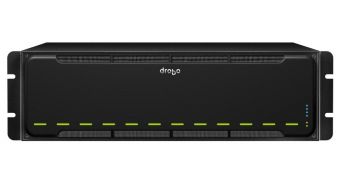Drobo has managed to come up with a series of very interesting NAS-type storage solutions up until now, and now, the company's back with quite a few additional offerings that target SMBs (small and medium businesses) specifically.
The new products reveale today are an 8-bay file sharing Drobo with remote backup, an 8-bay SAN (iSCSI-attached) Drobo, as well as an impressive 12-bay SAN (iSCSI-attached) Drobo with expanded redundancy features, support for thin provisioning and deprovisioning, and new data-aware tiering technology.
According to the company, the new storage solutions are designed to work as primary and secondary storage for Microsoft Exchange, Sharepoint and similar business applications, as well as file-sharing or offsite backup, while also supporting VMWare or other server virtualisation deployments and packing Drobo's trademark BeyondRAID technology.
“VMware recognises the importance of affordable storage alternatives for firms implementing virtualisation as they continue on the path towards IT as a service,” explained Parag Patel, vice president, global strategic alliances, WMware, who also added that “like larger organisations, SMBs are looking for ways to improve productivity and lower IT costs. Drobo streamlines VMware-virtualised storage for SMBs by delivering storage that is simple, scalable and automated – all with an affordable price tag.”
“Our customers aren’t shy; they have tried Drobo for themselves and are now demanding more Drobos for the rest of their business,” said Tom Buiocchi, CEO at Drobo.
“Our new Drobos for business storage continue to meld even more ‘big technology’ and ‘Drobo ease-of-use’ for the best storage experience ever,” Drobo's CEO concluded.
The new line of storage products from Drobo is already available for purchase directly from the company (apart from the 12-bay SAN, that will be shipping in Q2-11), pricing for the various models starting somewhere in the vicinity of 2,000 US dollars, which is not exactly a very small sum, but it's most likely quite worth it, especially since we're talking about SMBs here, not home users.

 14 DAY TRIAL //
14 DAY TRIAL //